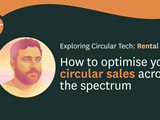How to optimise your circular sales across the spectrum
We recently had a conversation on HappyPorch Radio that touched on, in depth, our raison d'être: Using technology to enable greater circularity. To increase profitability. To decrease complexity. To extend a company’s longevity. While adding to the lives of their customers, and allowing them to live a lighter impact life.
We spoke with Ryan Atkins, Co-Founder and CEO of Supercycle, a circular commerce platform which enables rental, resale, membership of products of service and libraries of things, natively inside Shopify. It’s usable both by circular first startups, i.e. those building their business to come 100% from not new products, and linear businesses that are looking to tap into the profitability of introducing rental and resale in tandem with their existing business.
It was an exceptionally robust conversation, going into both broad and granular ways to launch and optimise such ventures, down to how to monetise and structure your taxes to best leverage not new inventory, and the most circular friendly 3PLs, among other things. Woven throughout it was the role well implemented, connective software can play in increasing circular rental businesses profit and longevity, substantially. Which we're right there for you to support.
If ever there were a podcast episode we’d encourage you to read the entire transcript, this would be it. Go ahead, we’ll wait :)
Meanwhile, today we’re going to take time to focus on two powerful distinctions which could well greatly open up your business: How rental and resale are in many ways just different facets of the same spectrum, and need not exist in isolation. And, reframing the common concern among currently all linear brands have, that resale & rental of their products will cannibalise new product sales.
Resale = Rental
Ryan connected many dots when he said,
“I don't really love the words rental or resale.
They're all kind of the same thing for me. They're all just cycles of a product. And then the money might happen at different points on that cycle, but there's an inbound leg, there's an outbound leg, there's an inbound leg, there's an outbound leg, and where the money happens in the cycle is really what defines it, whether that's clusters of resale or clusters of rental or clusters of products as-a-service. But it's all just the products coming in, coming out and payments happening at various different points along the circle. So we try (with Supercycle) to build it in a way which provides the full flexibility.”
When Ryan brought up a similar point while in conversation with Charlotte Morley of thelittleloop, a circularity infused children’s clothing hub that pivoted from rental to resale, she had an illuminating perspective on it:
“It's really insightful, Ryan, because what we did when we pivoted our business out of rental into resale was not, in actuality, abandoning rental.
We said, how can we make rental actually work for the consumer? Bear in mind we're in kidswear, we're not in high end luxury. It works in different ways, in different verticals and different consumers, but in kidswear rental was not working because people want to own their children's wear. They're terrified about damaging it.
We couldn't educate enough to break the cycle of ownership, what we could do was make a better user experience. We give them tools they can use, prompts (to resell) and just all the little subtle elements of how we do resale that effectively are delivering rental.
We don't really see a distinction in that way between rental and resale in terms of what the end goal is. Keeping those garments in circulation, making it as easy as possible for the customer to do it. The distinction is simply in, I hesitate to say this because I don't want to sound like I'm trying to lie to people, but it's tricking the consumer into thinking that they're doing it in a way that they’re more used to.
We're building it in a way that makes it easy for people because cognitively they're not having to think this is doing something different and it actually is, we're making it feel like they're not.”
A fascinating reframing of the customer experience, and perhaps applicable to your business?
Though in the case of Little Loop the choice to toggle from rental to resale was appropriate, in most cases you need not limit your business to one or the other. Or just those two. Subscription, membership, purchase of the same product can all happen as well, with relative ease. With software like Supercycle and the right fulfilment partners, you can meet your customers at multiple points on their journey, to the benefit of them and the profit of your business, the brands you work with. Impact maximised.
Let’s talk cannibalism
Typically, brands are concerned that if they offer their products for resale, it will eat into new product sales. Ryan tapped into an interesting reframe on the traffic coming to a brand’s e-commerce site:
“1% of those are maybe buying something and what you're offering to the other 99% I think that should be circular.
If you are the brand, you have much more margin to start with (as compared to a rentals/resale focused company) but oftentimes there's also a pool of stock set in not new returns. So there's often a cost center in your business from returns, which can no longer go back to a new condition that can then become the circular stock.”
Rather than leaving a great deal of your traffic on the table, why not find ways to activate it, while profiting from what would otherwise be written off, an expense?
Ryan went into far further detail about cannibalism (which you can fully delve into here.) but here are some key points:
“Does it cannibalise from your new sales? Sometimes yes. Sometimes no. Depending on the product, and it depends on the headspace. So with Peloton, for example, what we see is it's just going to be additional conversions that might not have happened before.
If you go onto a page and you're faced with a 2000 Pound purchase, there's a number of people that go, yes I'll commit. I'm confident enough that a Peloton is the right thing for me. It's something I wanna do. It's something I'm definitely gonna use and I'm willing to commit to buying that right now. I would say that those conversions would've happened and were happening anyway because they've always had the ability to purchase from new.
If you introduce a certified refurbished option, the people that think, “I really don't care about the ‘box fresh smell’, I wouldn't mind saving a few hundred pounds” before, they would've just definitely converted on third party marketplaces - on eBay, on Facebook marketplace or somewhere like that. And it might be that pre-loved or refurbished as Peloton call it, is more expensive on their own website. But is it worth the extra couple of hundred dollars to have it from the brand? Know, it's been refurbished. Know, it comes with the support. It comes with a warranty. Yes. I think it is worth that.
So they've captured some additional revenue that would've happened offsite. Now, some of the customers that would've bought from new, have they purchased from refurbished because it's right under there as an option? Probably, yes. So the equation now is: have I converted more overall, even though I've gained new customers that wouldn't have purchased from me, but then I've lost customers that purchased refurbished and not new. And you need to calculate that creation.”
But it can get even better, when a subscription option enters the equation. Putting himself in the mind of a would be customer of Peloton, Ryan says,
“So I like the idea of Peloton. But is it just gonna be another thing I buy and sits in the corner and I might be really passionate about it for two months and then it might just sit there and I'm really gonna kick myself? I've spent all this money and don't end up using it. If I can pay for it monthly, commit to three or four months and if I really love it, it's a long time before it would've been more cost effective to purchase it from new. But, I've taken the plunge because my risk is now so much lower.
The risk of buyer's remorse has disappeared and I think there’s a good 30, 40% of people that are hitting that product page that don't buy because of this fear of buyer's remorse. And I think that subscription option takes that fear away.”
The bottom line as we see it:
While there is some potential of new product sales cannibalism, incorporating rental, resale and subscription options as suits your business can greatly expand the pool of who becomes a customer, and how much information you get from them about your products along the way, leading to improved offerings on your end, and improved experiences on their end.
==
We’ll be back with another article inspired by this conversation, delving into the tech stack, collaborations and resources as he/we see it that will best enable your circular business’s success. Meanwhile, you can tune in, read the full transcript, and get all the relevant links here.


About the author
Paul Smith
Paul is a self-described communications Swiss Army Knife, having spent the majority of his career supporting beneficially impactful companies across the spectrum effectively tell their story to the world. The circular economy is a long time love of his, so he’s thrilled to now play a part in expanding its impact in the world. When not behind the computer, Paul can usually be found behind a book, on his bike exploring, or out for a walk in the forests of Fontainebleau, getting a closer look at the latest moss…